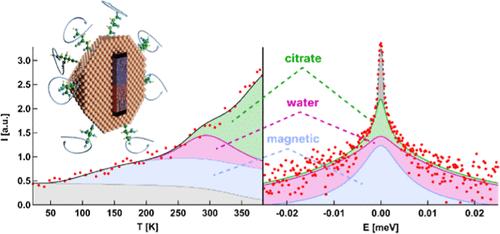当前位置:
X-MOL 学术
›
J. Phys. Chem. C
›
论文详情
Our official English website, www.x-mol.net, welcomes your feedback! (Note: you will need to create a separate account there.)
Quasi-Elastic Neutron Scattering of Citrate-Capped Iron Oxide Nanoparticles: Distinguishing between Ligand, Water, and Magnetic Dynamics
The Journal of Physical Chemistry C ( IF 3.3 ) Pub Date : 2024-06-26 , DOI: 10.1021/acs.jpcc.4c00479 Maksim S. Plekhanov 1 , Sabrina L. J. Thomä 1, 2 , Andreas Magerl 3, 4 , Markus Appel 5 , Mirijam Zobel 1, 4
The Journal of Physical Chemistry C ( IF 3.3 ) Pub Date : 2024-06-26 , DOI: 10.1021/acs.jpcc.4c00479 Maksim S. Plekhanov 1 , Sabrina L. J. Thomä 1, 2 , Andreas Magerl 3, 4 , Markus Appel 5 , Mirijam Zobel 1, 4
Affiliation

|
Experimental access to the diffusional properties of organic ligand molecules on nanoparticle (NP) surfaces is scarce, although surface functionalization is widespread in synthesis and for the control of functional particle properties. This work focuses on the dynamics of citrate ligands and water molecules on the surface of 6 nm iron oxide NPs (IONPs) equilibrated at a relative humidity of 8% by quasi-elastic neutron scattering. Given the complex quasi-elastic scattering signal including the magnetic nature of the IONPs, we build on fixed window scans to separate multiple dynamic processes, namely, phonons, magnetic relaxations, and hydrogen dynamics. In addition, deuterated samples allowed us to separate the ligand and water dynamics. With a simultaneous fit approach, multiple fixed window scans and energy-resolved spectra are described to determine the activation energies and relaxation times. It is found that surface-bound citrate ligands rotate continuously with Ea = 240 meV and τ0 = 0.21 ps, while surface water diffuses translationally with Ea = 190 meV and τ0 = 0.12 ps, significantly slower than bulk water. The separation of the coexisting dynamic processes in this study proves the high potential of quasi-elastic neutron scattering to reach a detailed understanding of interfacial processes in nanostructured materials.
更新日期:2024-06-27






































 京公网安备 11010802027423号
京公网安备 11010802027423号